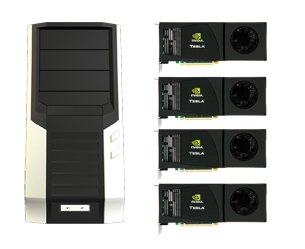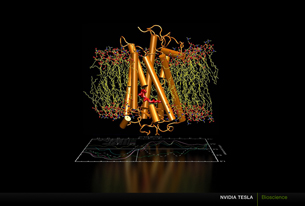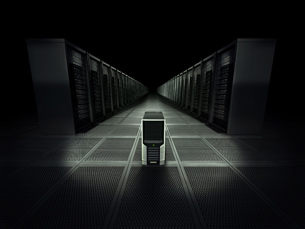NVIDIA Delivers the Personal Supercomputer
Tesla GPUs make desktop cluster-level computing performance accessible.
Latest News
January 14, 2009
By Margaret S. Gurney
|
NVIDIA Corp. (Santa Clara, CA) announced its GPU-based Tesla Personal Supercomputer at SuperComputing ‘08. Said to deliver the equivalent computing power of a cluster at 1/100th of the price and 1/20th the power, the NVIDIA Tesla Personal Supercomputer features up to four Tesla C1060 GPU (graphics processing unit) cards, which is based on the company’s CUDA parallel computing architecture, and powered by up to 960 parallel processing cores.
A Tesla Personal Supercomputer is no bigger than a typical desktop workstation and plugs into a standard power strip. Personal Supercomputers using the Tesla C1060 GPU processors will enable engineers, researchers, and scientists to run complex, data-intensive simulations, experiments, and large number-crunching jobs from their desktops without resorting to a shared cluster, according to NVIDIA.
“NVIDIA and its partners will be delivering outstanding performance and broad applicability to the mainstream marketplace. Heterogeneous computing, where GPUs work in tandem with CPUs, is what makes such a breakthrough possible.” |
Already, Tesla Personal Supercomputers leveraging NVIDIA’s Tesla GPUs have been announced by such manufacturers as AMAX, Boxx, Dell, Lenovo, Microway, and Western Scientific. NVIDIA estimates that workstations incorporating four Tesla C1060 cards will sell for less than $10,000 while offering processing speeds of approximately four trillion floating point operations per second (4 teraflops.)
Technical Specifications
NVIDIA explains that you gain such levels of compute capability from Tesla GPUs in large measure because of its CUDA massively parallel computing architecture, which, NVIDIA says, unlocks the power of parallel computing by simplifying multi-core programming. Coupled with a multi-core processor from AMD or Intel, a Tesla GPU and its 240 scalar processor cores enable high-performance compute-intensive applications to scale efficiently. This multi-core CPU/many-core GPU combination, in turn, enables cluster-level performance in a desktop workstation form factor, while using less energy and fewer system resources than a cluster data network.
 Tesla Personal Supercomputer, powered by four Tesla GPUs, is no bigger than the size of a typical workstation. |
The supported platforms for the NVIDIA Tesla Personal Supercomputer include Microsoft Windows XP (64-bit and 32-bit), Linux 64-bit and 32-bit (64-bit recommended), Red Hat Enterprise Linux 4 and 5, and SUSE 10.1, 10.2, and 10.3.
Tesla architecture includes a massively-parallel many-core architecture; 240 scalar processor cores per GPU — which can execute thousands of concurrent threads; integer, single-precision, and double-precision floating point operations (FLOPS); a Hardware Thread Execution Manager that enables you to harness thousands of concurrent threads per GPU; a parallel shared memory that enables processor cores to collaborate on shared information at local cache performance; and ultra-fast GPU memory access with 102GBps peak bandwidth per GPU.
Plus, IEEE 754 floating-point precision (single-precision and double-precision) provides results that are consistent across platforms and meet industry standards. The 64-bit arithmetic logic units (ALUs) for double-precision math can meet the precision requirements of the most demanding applications, says the company.
 Tesla computing solutions help solve computational problems in biosciences and medicine. |
Software development tools include C language compiler, debugger, profiler, and emulation mode for debugging; standard numerical libraries for FFT (Fast Fourier Transform), BLAS (Basic Linear Algebra Subroutines), and CuDPP (CUDA Data Parallel Primitives).
Other product details indicate that the high-speed memory is due to up to four Tesla C1060 computing processors with 4GB of dedicated memory per GPU. This dedicated compute memory enables larger datasets to be stored locally for each processor to maximize benefit from the 102GBps memory transfer speeds and minimize data movement around the system.
Who Benefits
Nowadays, with most scientific research being carried out on supercomputing clusters, researchers often must compete for time to use the shared resources that not only consume hundreds of kilowatts of power but also cost millions of dollars to build and maintain. At best, this can slow their work and delay results.
This is where the GPU-based NVIDIA Tesla Personal Supercomputer comes in. It has enabled such institutions as MIT, the Max Planck Institute, the University of Illinois at Urbana-Champaign, Cambridge University, and others to advance their research because they are using GPU-based personal supercomputers, says the company.
Tesla computing solutions help solve oil discovery problems through complex computation. |
Today, GPU-based Tesla Personal Supercomputers are available from HPC OEMs, systems builders, and resellers such as the six companies mentioned earlier (AMAX, Boxx, Dell, Lenovo, Microway, and Western Scientific) as well as globally from Armari, Asus, Azken Muga, CAD2, CADnetwork, Carri, Colfax, Comptronic, Concordia, Connoisseur, Dospara, E-Quattro, JRTI, Littlebit, Meijin, Sprinx, Sysgen, Transtec, Tycrid, Unitcom, Ustar, and Viglen, according to NVIDIA.
“We’ve all heard ‘desktop supercomputer’ claims in the past, but this time it’s for real,” said Burton Smith, Microsoft Technical Fellow. “NVIDIA and its partners will be delivering outstanding performance and broad applicability to the mainstream marketplace. Heterogeneous computing, where GPUs work in tandem with CPUs, is what makes such a breakthrough possible.”
For more information on the GPU-based NVIDIA Tesla Personal Supercomputer, please visit NVIDIA.
Read why DE’s editors chose this as a Pick of the Week.
To learn more about the industry-changing applications benefiting from NVIDIA GPU Computing technology, visit NVIDIA CUDA.
Access the datasheet on the NVIDIA Tesla Personal Supercomputer.
For Tesla Personal Supercomputer features and benefits, Technical specifications or distributors, visit the Tesla product family page.
Read Tesla success stories.
See what developers are saying about GPU computing on the Tesla channel at YouTube.
If you would like more information surrounding the NVIDIA Tesla Personal Supercomputer, you can read any of the supporting press releases issued by NVIDIA.
- CUDA Cleans Up At SuperComputing Industry Awards
- NVIDIA Tesla Gives Bull Customers A Revolutionary Performance Boost
- NVIDIA and CRAY To Deliver Tesla-Enabled CRAY CX1 Desk Side Super Computer
- NVIDIA and NEC Collaborate To Deliver GPU Computing Solutions To HPC Market
- NVIDIA Tesla TurboCharges High-Performance Computing Industry With HP Proliant Servers
- Mathematica Users Get 100x Performance Boost From NVIDIA CUDA
- NVIDIA Demonstrates Powerful GPU Computing Solution From Lenovo At SC08
- Tokyo Tech Builds First Tesla GPU Based Heterogeneous Cluster To Reach Top 500
- OpenGeoSolutions Transforms Seismic Modeling with NVIDIA TESLA
Margaret S. Gurney is the editor for new products at Desktop Engineering magazine.
Subscribe to our FREE magazine, FREE email newsletters or both!
Latest News
About the Author
DE’s editors contribute news and new product announcements to Digital Engineering.
Press releases may be sent to them via [email protected].







